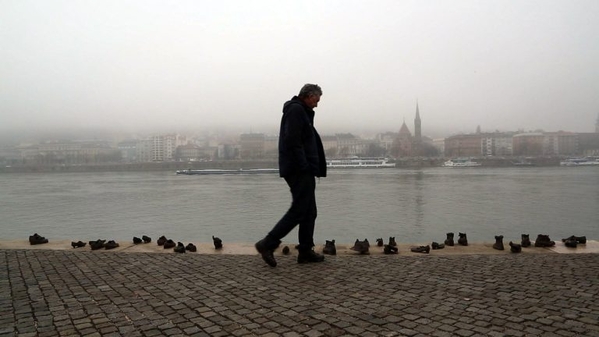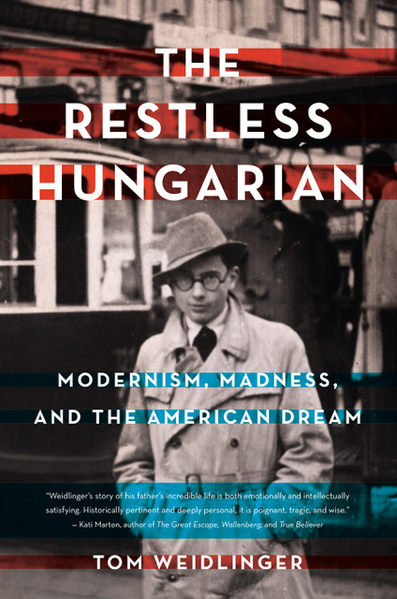Tom Weidlinger, an award-winning documentary filmmaker and author, realized his childhood was traumatic when he was a teenager. He tells the story in his memoir, The Restless Hungarian. He was in a car with his mother. She had just picked him up from boarding school where he had been sent after his parent’s divorce. She was speeding and swerved violently off the road. “We almost had a crash,” he said, still shaken by the close call with death.
“Didn’t you see him,” his mother asked, “the man who was trying to shoot us?”
“No, mom. I didn’t see him.”
Although she had spent time in mental institutions during his boyhood, this was the first time Weidlinger allowed himself to consciously acknowledge his mother’s mental illness. With a diagnosis of paranoid schizophrenia, Weidlinger’s mother perceived the world as a hostile place and kept her son very close. She often told him, “People are spying on us and we have to be careful.”
“In order to be loved by my mother,” the 68-year-old filmmaker and author explains, “I had to accept her world view. I was 14 years old when I finally understood that staying with my mother was dangerous. I ran away from home and hitchhiked to Portland, Oregon, to stay with my older sister.”
His mother called the police to force him to come home. “After that, I convinced myself that I hated her and did not need her love,” he recalls. “When she called me at boarding school, I shouted obscenities at her over the phone.”
It wasn’t until he convinced his father to transfer him to a small Quaker boarding school—The Meeting School—in New Hampshire that the teenager found the teachers who would become his surrogate parents. “For the first time I had a sense of family and relationships that seemed normal,” he says. “Going to The Meeting School saved my life.”
One experience, similar to schools that now embrace policies and practices based on positive and adverse childhood experiences (PACEs), was how Weidlinger’s school dealt with kids who violated school policies. “You wouldn’t be expelled for smoking dope,” he says. “A committee of three people, which included a student, would meet with you. The approach was restorative rather than punitive. There was a lot of love and we students really felt that. For me, it was an extraordinary process of growth.”
Discovering his father’s secret
When he was in his 40s, Weidlinger asked his father to travel with him to his native Hungary so he could learn about his family. Paul Weidlinger, a structural engineer who worked with some of the 20th century’s most famous modern architects, never talked about what had happened to his own family during the Holocaust. While many perished, he fled Europe in 1939, first to Bolivia and then to the U.S. in 1943. He never told anyone in the U.S., including his son, that he was a Jew.
 Paul Weidlinger only stayed with his son in Budapest for three days. After he left, Tom Weidlinger said his Hungarian cousin took him on a walk through the city. They visited Dohány street synagogue, where they viewed a display of false IDs used by Jews to try to escape the Nazi roundups in 1944.
Paul Weidlinger only stayed with his son in Budapest for three days. After he left, Tom Weidlinger said his Hungarian cousin took him on a walk through the city. They visited Dohány street synagogue, where they viewed a display of false IDs used by Jews to try to escape the Nazi roundups in 1944.
Weidlinger asked his cousin why it was so important to show him this display. “I’m Jewish,” he said, “and so are you.” To prove it, he showed Weidlinger similar false identity papers for his grandparents as well as marriage and birth certificates identifying everyone, including Paul Weidlinger, as Israelite or Jew.
“I was stunned,” says the filmmaker, “and then pieces of the puzzle began to fall into place.” Later, when he gently confronted his father about this, he saw his father’s face collapse. “It was only for a few seconds, but I had never seen that expression on his face before. It was intense fear and trauma.”
“His father said, ‘No, we’re not Jewish.’” Shocked by his parent’s denial and the fear in his face, Weidilnger didn’t press the issue. They never spoke of it again.
Confronting past trauma triggers panic
After his father died in 1999, Weidlinger received a box of documents from his stepmother. Five years passed before he opened it. “I started reading some of my father’s papers and immediately became very sleepy,” he recalls. “There was stuff I didn’t want to know. I realize now that my unconscious was protecting me.”
Around this time, he was contacted by an architect who wanted to restore unique mid-20th-century homes in Cape Cod—including one that Paul Weidlinger had built. As a child, Weidlinger had spent summers in this house with his mother. Now derelict, the house had been donated by his mother to the National Park Service.
Weidlinger went to look at the ruin. When he opened the door and stepped inside, he was overcome. “I had a panic attack,” he says. “All the crazy, horrible things that my mother did when I was a child came back to me. I literally ran out of the house and told my wife, ‘I’m never coming here again.’”
Rebuilding his home and his family relationships
Weidlinger was not sure what prompted him to return to the house in 2013 to lend a hand with its restoration, using carpentry skills he’d learned as a young man. “I just had a feeling it was something that I needed to do,” he recalls.
This time, when he arrived, he didn’t panic. “A group of volunteers worked together on the house,” he says. “As I became engaged with the physical work, I was often transported back to my childhood, remembering my life there as a boy. At the same time, I became fascinated with the beauty of the structure. It made me want to know more about the man who had designed it. When I returned home, I opened the box of my father’s documents and finally start to read them. I was not sleepy anymore.”
Using a part of an inheritance he received after his father’s death, he resolved to make a documentary film about his father. He traveled across three continents to trace his father’s footsteps, to visit the buildings he had designed and engineered, to interview people who had known his father, and to meet Jewish relatives he had not known existed.
Through this process, Weidlinger came to understand that he was filling in the gaps in his father’s own life narrative that were a result of suffering and trauma that occurred long before his son was born. The filmmaker, who didn’t learn about the CDC-Kaiser Permanente Adverse Childhood Experiences Study until this interview, calls these gaps in his father’s narrative “a kind of psychic cauterization, which deeply impacted his ability to be a father to his son.”
 An eight-year investigation led to both a film and a book, which delves deeply into the historical context of family trauma. In the last paragraph of the book, Weidlinger writes, “I believe there is a… purpose in descending into the depths of the past and befriending the sorrowful souls who still dwell there in our hearts…”
An eight-year investigation led to both a film and a book, which delves deeply into the historical context of family trauma. In the last paragraph of the book, Weidlinger writes, “I believe there is a… purpose in descending into the depths of the past and befriending the sorrowful souls who still dwell there in our hearts…”
Naming family members across generations, he continues, “I have done this… hoping not only to make them completely real in my heart, but perhaps reaching through the veil of time and space, to let them know they are truly seen, honored, and loved. I say to them, ‘Look, dear family. I am well. I am alive. And I embrace you.’”
The Restless Hungarian was published in 2019. The book chronicles how a deep understanding and empathy for intergenerational trauma can heal and end a cycle of pain and denial passed down from one generation to the next.
Weidlinger’s film with the same title will debut later this year. He has also written extensively and created videos in his blog about the evolution of this project.





Comments (0)